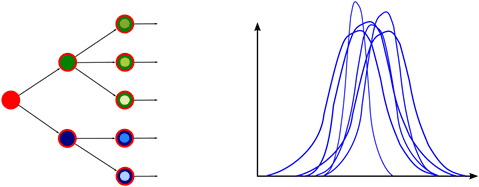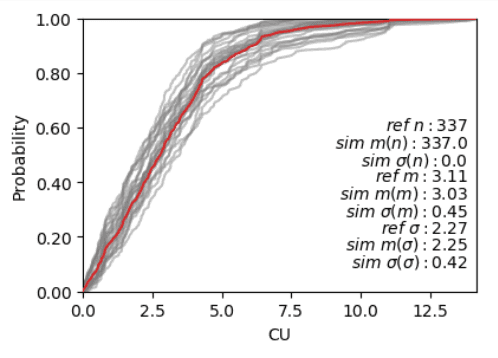An important goal of modern resource modeling is accurate and precise assessments of uncertainty for production volumes relevant for technical and economic decision making. Volumes of relevance often relate to weekly, monthly, quarterly or annual production. These volumes are large and, for the most part, short scale high-frequency variations cancel out. This explains why simulated realizations from a fixed modeling workflow with fixed parameters often understate uncertainty. Careful consideration of large scale geological uncertainty is required to provide realistic asessements of production uncertainty. There are alternatives to incorporate such larger scale uncertainty.
A scenario in geological modeling is a possible succession of depositional and diagenetic geological events that would lead us to a specific sequence of modeling steps. As illustrated on the left, scenarios may branch. There may be multiple plausible scenarios for a particular deposit related to, for example, the structure and continuity of the high grades. The parameters of a geostatistical model include proportions, histograms (on the right), variograms, training images or other settings that are required before running a modeling step. Parameter uncertainty is the explicit consideration that the input parameters to a modeling step are themselves uncertain. The distinction between scenarios, parameters and realizations is arbitrary; other fields of application use the words differently. In our geological modeling context, the relative importance of scenarios versus parameter uncertainty is debated.

There is little doubt that multiple scenarios are important in exploration where the conceptual geological model is unclear. The difference between scenarios may be larger than any variation in parameters. As additional drilling becomes available and a deposit moves to pre-feasibility and feasibility, the conceptual geological model becomes more clearly understood and parameter uncertainty dominates the assessment of production volume uncertainty. Finally, for short term modeling just ahead of mining, a data driven assessment of uncertainty may be sufficient. When should scenarios and parameter uncertainty be considered?
The short answer is “whenever possible”, but scenario and parameter uncertainty are absolutely required for realistic large scale production uncertainty. If alternative scenarios can be plausibly formulated, then geological models should be built for each scenario. The selection of scenarios and the assignment of probability to each is necessarily subjective. This is not a limitation, but an important feature of uncertainty assessment. Although I admit that (like most people) “I trust my expert judgement, but question your subjectivity”. Considering a variety of views – some contrary to the consensus view – leads to improved uncertainty assessments. The meaning of probability is compromised when there are drastically different scenarios; nevertheless, knowing how resources change for different scenarios is important decision support information.
As one scenario emerges as the universally accepted conceptual model, the modeling workflow should be kept flexible enough to include the remaining large scale uncertainty. Geological boundaries, surfaces and parameters must be considered uncertain. It is unreasonable to freeze large scale features of the geological model, then vary grades at a small scale. The consideration of scenarios and parameter uncertainty are not mutually exclusive. Parameter uncertainty can be used with different scenarios. Yet, in practice, there seems to be a transition point from scenarios (early on) to parameter uncertainty (through long and medium term models).
Numerous studies have supported the multivariate spatial bootstrap (MSB) as the main tool for parameter uncertainty. The MSB can be adapted to geometric variables, categorical variables and to uncertainty in presence of a trend. The figure below shows a reference distribution (red line) and multiple realizations from the MSB to be used as alternative inputs in simulation. The MSB provides a measure of prior uncertainty, that is, before conditioning to data and clipping by geological limits. The posterior uncertainty after conditioning and clipping provides accurate and precise assessments of uncertainty in large scale production volumes.

Geological boundaries and surfaces are critical to large scale uncertainty. These are neither scenarios nor parameters, but their uncertainty may be the most important for practical production volumes. Dilating and eroding boundaries within a reasonable range of uncertainty is recommended. Allowing surfaces to vary is also recommended. Assembling the realizations together accounting for all reasonable scenario, parameter and data uncertainty provides a basis for modern probabilistic resource modeling.
Resource Modeling Solutions (RMS) focuses on workflows and a software platform for resource modeling that leads to accurate and precise production volume uncertainty. The consideration of scenarios, boundary, surface, parameter and data uncertainty in a unified framework has been built into the workflows and platform from conception. Geological modelers are enabled to embrace a probabilistic view and provide a fair assessment of resources and reserves.



